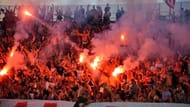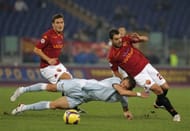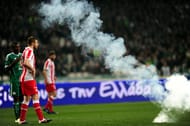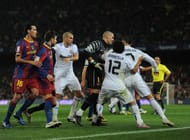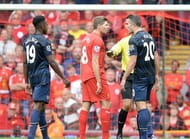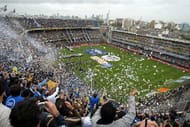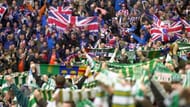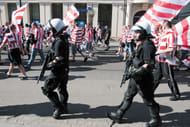Derby. The word itself instills a feeling of passion, anxiety, love and sometimes, fear. A derby is much more than 3 points. It’s about prestige. It’s about bragging rights. When it’s a derby, it’s not just about 90 minutes, it’s a lifetime. It’s not passion, it’s emotion. It’s no longer a game, it’s life. Here we take a look at some of the most intense derbies in the game of football.
Fenerbahce vs Galatasaray
Though matches between the two Istanbul outfits have been a usual affair since 1909, it was on 23rd September 1934 that things intensified. After lots of crunching tackles and foul-mouthed tirades, the referee abandoned the game midway and that was the end of ‘friendly’ encounters between the two sides. Now hooliganism ranging from tearing seats to stabbing the opposition fans is commonplace in the K?talar Aras? Derbi. And Graeme Souness on the night of a Cup final in 1996 took the biggest Turkish rivalry to a whole new level when he planted his team’s flag in the centre of the pitch. At the home of Fener, the ?ükrü Saraco?lu Stadium. Another major factor leading to the eternal dispute is geographical division. Things don’t get any better when the city is separated by a mass of water, with Fenerbahce being from the Asian side of Istanbul and Galatasaray being from the European half. The hatred for each other is so fanatical that even the players get into the act and on some occasions, the bout is no less than a dog-fight.
Red Star Belgrade vs Partizan Belgrade
Also termed the Eternal derby, this affair is considered one of the hottest affairs in Serbia given the fact that the two clubs share a duopoly in the Serbian SuperLiga. Usually attracting large audiences, violence during the match is not uncommon and in 1999, 17-year old boy was killed by a flare let off by the opposition stand. The most recent outing was fiery affair. Quite literally, when the Partizan fans set the Red Star Stadium ablaze and hurled rubbish to intensify the flames. While Red Star is streets ahead when it comes to trophies and accolades, the influence of the derby is diminishing with corruption allegations rife in the entire Serbian football system. With both teams standing out in an ocean of mediocrity, a contest between the two is a treat for the eyes.
AS Roma vs Lazio
In Italy, it doesn’t really get any bigger than this. Hatred came to rise in 1927, when then dictator Benito Mussolini urged three clubs to come together and form a single club – AS Roma, so as to prove formidable opposition to the northern clubs of Italy. But Lazio refused point blank and since then, the Roman derby has witnessed riots, bloodshed and, unfortunately, on many occasions death. After the merger, Lazio found themselves as outsiders as their fan base was minuscule as compared to AS Roma’s. AS Roma supporters thereafter taunted their rivals as ‘peasants’ as Lazio were ousted to the outskirts of Rome. The epicenter of this epic rivalry, unlike most others, is territorial conflict, with Lazio fans believing that Roma has taken away what was rightfully theirs – Rome herself. On derby day, the Stadio Olimpico, shared by both teams, is no longer a picture of its usual self. It’s reminiscent of the Colosseum – the original battleground. It’s no longer football match. It’s a match between gladiators. It’s a duel to the death. It’s the Derby della Capitale.
Olympiakos vs Panathinaikos
Derby of the Eternal Enemies. The name speaks for itself. Greek fans have gained immense ill repute for the savage nature and ‘unprincipled behavior’ of theirs and this attitude is put on display during the contest between the greatest Greek teams of all time – Olympiakos & Panathinaikos. Panathinaikos, in the mid-1900s, represented the elite class of Athens while Olympiakos represented the working class of Piraeus, a port in Athens. Though Panathinaikos treated their rivals as scum from the very beginning, Olympiakos always had the larger fan base as they represented the class oppressed and exploited by the aristocrats of Greece. Although this cultural division has diminished over the years, the hatred the clubs have for each other has not decreased one bit. With both clubs adopting different political ideologies, undoubtedly sparks fly during derby day and the players too go all guns blazing. With flares, Molotov cocktails, rioting, pre-arranged fights a regularity on match day, it isn’t a surprise they call it ‘The Mother of All Battles’.
Ajax vs Feyenoord
Now we have a look at the most important fixture of Dutch football – Ajax against Feyenoord. This everlasting feud between these two clubs can be also seen as a rivalry between two of the greatest Dutch cities – Amsterdam and Rotterdam. Rotterdam, known for being home to the cheap laborer, is home to Feyenoord, club of the people and Ajax being the club of rich and is seen as the city for the vacationer. Despite being only 60 odd kilometers apart from each other, the two cities have contrasting cultures. Rotterdammers have always considered the Amsterdammers as cocky and lazy, while Amsterdammers treat their rivals no less than first rate vermin. Violence has often marred the games between two clubs and in 1997 an Ajax fan, Carlo Picorni, was beaten to death with steel rods in a pre-arranged fight. To prevent such an atrocity again, heavy presence of riot police is a must on derby day. And from February 2009, visiting team fans have been barred from watching away games for 5 seasons, to curb the riots. With both teams showing unadulterated hate for anything 60 kilometers away from home, it truly is De Klassieker.
FC Barcelona vs Real Madrid
This list was never going to be complete without this rivalry. THE El Clasico. Arguably the greatest and certainly the most famous rivalry on the face of the earth. And in recent Clasico’s clashes two players have had a major chunk of the limelight – Lionel Messi and Cristiano Ronaldo, the two best players in the world and important cogs in their teams’ wheel of progress. And the two new multi-million dollar recruits – Neymar and Gareth Bale have only fueled the flames. Fan violence hasn’t been much of an issue but a few incidents stand apart. For instance Luis Figo was given quite a hostile reception at the Camp Nou when he returned to play against his former employers in the Real Madrid whites and had a pig’s head thrown at him. Barcelona were a symbol of Catalan pride representing the public, while Real were formed by the king of Spain, a club for the wealthy elites. This difference laid the foundation to the most glamorous rivalry ever, a rivalry which is celebrated with as much pride and honour as it was half a century ago and will continue to, in the generations to come.
Liverpool vs Manchester United
Arguably, the biggest rivalry in English football, the fact that both clubs are the most successful teams in Britain, makes this rivalry. While Manchester United have won 20 league titles as compared to the Reds 18, the latter has won the European Cup 5 times compared to the Red Devils’ 3 triumphs. Controversy has never been too far away from this fixture, with Luis Suarez, most recently coming into spotlight for racially abusing Frenchmen Patrice Evra. Former manager and Old Trafford legend, Sir Alex Ferguson openly stated that ‘knocking Liverpool off their f***ing perch’ was his prime goal. Another rather unknown fact is that no player since 1964, has transferred directly between the clubs, which throws light upon the loathing these adversaries display towards each other and the wrath a player would have to face if he did so. While Manchester was a cotton hub, Liverpool was a major port of Britain and during the 1970s the rivalry came to prominence, representative of the fact that this is an economical rivalry. Hooliganism has now decreased in these games, largely owing to the fact that matches are played in the afternoon which discourages drinking before games. But let there be vandalism or no vandalism; it certainly is a clash of the titans.
Boca Juniors vs River Plate
When this event is at the summit of ’50 sporting things you must do before you die’, there is undoubtedly something that sets the Superclásico apart from other derbies.. With both teams sharing a duopoly in the Argentine Primera Division, it isn’t a surprise that it is an intensified match. The noise levels, unfurled flags, vibrant colors, loud banners, unending fireworks, maniacal fans and the general level of energy makes your average derby look like a picnic. River Plate is referred as Los Millonarios (the Millionaires), while their cross-town arch-rivals are known as the people’s club but today, both clubs have almost equal support in Argentina. Boca fans have labeled the River fans ‘las gallinas (chickens) – for choking in big games, while the River fans call the Boca fans ‘los bosteros’ (pieces of sh*t) – with Boca being based in the unclean and less affluent neighborhoods of Buenos Aires. And both set of fans have learned to live with these bitter names and are even proud of it. And switching loyalties incurs the fury of the fans and you are instantly termed a traitor. By fans of both clubs. Diego Maradona, a cult legend at Boca proclaimed that he would not move to River under any circumstance. In Buenos Aires, they say you can change your job, your friends, wife and even religion but you can NEVER change your team.
Celtic vs Rangers
What makes the Old Firm unique is that, this is unquestionably the most complex derby in the world. Several factors like politics, attitudes, contrasting ideologies, locality, and finances are intertwined together to make this one hell of a game but one aspect which makes this derby stand out is religion. Celtic representing the Irish folk in Scotland, were predominantly Roman Catholics, while on the other hand Rangers represented the Scottish natives and were Protestants. What intensifies things is that both clubs have different political ideologies and this contributes to the rivalry surrounding the two giants form Glasgow. Sectarian chants are commonplace during Old Firm clashes and such is the impact of the match that tremors are often felt even in the neighboring countries of Northern Ireland and Ireland in the form of riots. And ever since the 2nd World War, no player has moved to other club in a direct transfer. Many-a-times passion takes the better of fans and games are marred by fan violence and one occasion the game had to be stopped because a missile thrown from the stands had hit the referee. Fans subsequently invaded the pitch and insurgence ensured and later 113 people were arrested. With the entire nation glued to their TV sets on derby day, the Old Firm is said to be worth a whooping £120 million to the Scottish economy.
Wisla Krakow vs MKS Cracovia
Though this may not be the most famous of derbies, I assure you, it is definitely the fiercest. Poland is the home of football hooliganism and each club in the Polish league has its own group of hooligans called firms. There’s a document called the ‘Poznan Agreement’, in which firms all across Poland agree not to use weapons during fights. Wisla and Cracovia are the only two teams not to sign the document. This shows the extent of the animosity these clubs share for each other and utter disregard for other clubs. In most countries, vandalism and hooliganism in football can be usually credited to a drunken escapade. In Poland this isn’t the case. Members of the firms train and work out everyday to ready themselves for the day of battle. Wisla, once owned by the communist police, are referred to as dogs by the Cracovia supporters who are in turn termed ‘Stripes’ or Jews due to their Jewish roots. Despite the fact that the stadiums are barely half-a-kilometer apart, supporters of the away team are gathered at their own stadium and then escorted to the other stadium. In armored vans. The Holy War, aptly named indeed.
